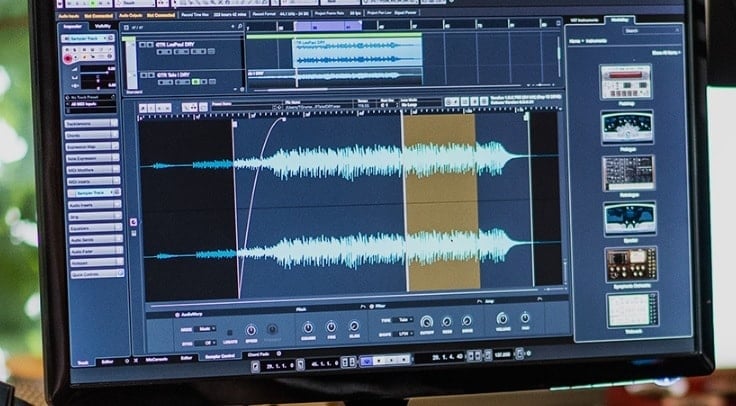

- #WHAT IS THE BEST MUSIC EDITING SOFTWARE FOR FREE#
- #WHAT IS THE BEST MUSIC EDITING SOFTWARE FULL#
- #WHAT IS THE BEST MUSIC EDITING SOFTWARE PRO#
- #WHAT IS THE BEST MUSIC EDITING SOFTWARE MAC#
- #WHAT IS THE BEST MUSIC EDITING SOFTWARE WINDOWS#
You can save your frequently-used actions so they're always a click away under the Favorites menu.

You can also use adaptive noise reduction (which intelligently detects undesirable sound for you) and automatic or spot healing to remove pops and clicks. Adobe also added best-in-class audio restoration tools, allowing you to grab a sample of "noise" in your recording, then remove that unwanted range of sound from the entire file. The app can be used as a fully-fledged digital audio workstation with support for recording multiple sources at once as well as external plugins (VST, VST3, and AU). The app is updated every year with new features and expanded compatibility with the latest versions of macOS and Windows.Īudition can function both as a single-track audio editor, and as a multi-track mixer for recording and layering sounds. WaveLab Elements (macOS, Windows) for an alternative to Adobe Audition, without the subscriptionĪdobe Audition CC is a powerhouse audio editor that continues to push industry standards forward, with a pricing model to match.
#WHAT IS THE BEST MUSIC EDITING SOFTWARE MAC#
TwistedWave Mac (macOS) for multi-channel editing and effects on a Mac TwistedWave Online (Web) for quick, web-based edits
#WHAT IS THE BEST MUSIC EDITING SOFTWARE WINDOWS#
SOUND FORGE Audio Studio 12 (Windows) for Windows users on a budget Hindenburg Journalist (macOS, Windows) for journalists and podcasters
#WHAT IS THE BEST MUSIC EDITING SOFTWARE PRO#
Ocenaudio (macOS, Windows, Linux) for simple, fast edits for freeĪcoustica Standard Edition (macOS, Windows) for creating and deploying effect chainsĪmadeus Pro (macOS) for one-click audio repair and batch operationsįission (macOS) for quick and simple edits on a Mac
#WHAT IS THE BEST MUSIC EDITING SOFTWARE FOR FREE#
Others specialize in compressed lossless files (FLAC, Apple Lossless) and less common lossy formats (OGG, MPC).Īdobe Audition CC (macOS, Windows) for an all-around editor at a priceĪudacity (macOS, Windows, Linux) for multi-track editing and recording for free Simple editors only deal in basic uncompressed waveform audio (WAV) and common lossy formats (MP3, AAC). Lastly, support for a wide array of audio files and formats may be important to some users. The ability to manipulate and mix audio into a video file-known as "muxing"-removes the need to render large video files for small audio edits. If you're editing audio for use in a broadcast, adherence to common broadcast standards should make life easier. Some editors even support external effects via plugins. These include compressing tracks to smooth out recordings that vary in volume, using an equalizer to boost or cut particular frequencies, and applying filters that drastically change the sound of your file. Effects are useful for repairing and enhancing your audio too. They also use more system resources than simple destructive waveform editing.Īudio editing isn't just about recording and moving around sound files. You might find these features handy if you're putting together a podcast and want to use sound effects or background music alongside your primary audio track. These may support the recording of multiple sources at once or non-destructive clip-based edits. Others offer one-click repairs to remove hiss and pops from your recording.įor more complex projects, a multi-track editor may be required. Some editors take this a step further and handle audio levels for you. An uncluttered interface and simple workflow ensure unnecessary features don't get in the way of the basics. Some apps make it easy for the less experienced audio editor. Not all of these features are essential to everyone looking for audio editing software, and your final decision will depend on the task at hand and your overall level of expertise: We've selected a variety of apps that bring something unique to the table.

These kinds of simple waveform edits are often referred to as destructive editing, where edits you make to the file overwrite the original when you click Save. You should be able to use any of these apps to trim an audio file down to size or merge two files together. This is the bread and butter of audio manipulation, including recording from a microphone, selecting audio on a waveform, copying and pasting, and deleting audio from the timeline.
#WHAT IS THE BEST MUSIC EDITING SOFTWARE FULL#
Every editor we've chosen has a full set of basic editing controls.


 0 kommentar(er)
0 kommentar(er)
